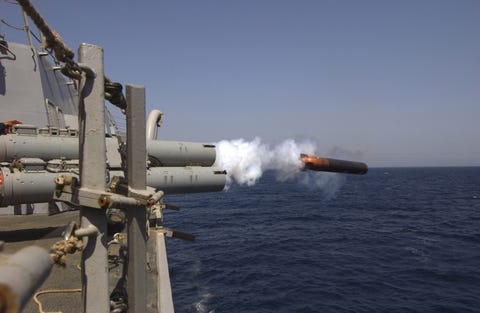How the U.S. Navy Launches Anti-Submarine Torpedoes from Ships
The torpedoes are designed to home in on enemy submarines.
By Kyle MizokamiA video on YouTube shows the dramatic way U.S. Navy warships launch submarine-hunting torpedoes.
The Mark 32 Triple Torpedo Tube (TTT) launcher allows cruisers and destroyers to participate directly in anti-submarine warfare, hunting down submarines with acoustic homing torpedoes. The Mark 32 uses a pneumatic ejection system to launch torpedoes away from the sub-hunting ship and into the sea.
One of the primary missions for U.S. Navy surface warships is anti-submarine warfare. During the Cold War, the Soviet Navy maintained hundreds of submarines designed to sink U.S. aircraft carriers and sever the supply route between Europe and North America during wartime. As a result, anti-submarine warfare became a high priority and almost every frigate, destroyer, and cruiser became equipped to hunt submarines.
The Mark 32 Triple Torpedo Tube launcher was an easy way to quickly boost anti-submarine firepower. The system consists of three fiberglass-reinforced polyester resin torpedo tubes bundled together on a swivel mount, each of which contains a Mk. 46 Mod 5A(S) lightweight antisubmarine torpedo. The tubes are stored running parallel to the ship and rotated to face outwards during live-fire exercises or combat. Upon command, either triggered remotely or from the Mark 32 launcher itself, a burst of compressed air shoots the torpedo out of the tube and into the water.
The Mark 46 torpedo was first introduced in 1963 and progressively updated ever since. Considered a “lightweight torpedo,” the Mark 46 is just a foot wide, 8.5 feet long, and has a 99-lb. high explosive warhead. Although relatively light, the warhead is powerful enough to inflict serious if not potentially fatal damage on a submarine’s pressurized hull.

Mk. 46 torpedo ejecting from the Mk.32 torpedo launcher.
PH1 AHO
Once launched, the Mk 46 enters the ocean and immediately starts searching for enemy submarines. The torpedo enters a “snake” or “circle” search pattern, moving at slow speed to minimize its own noise until it zeroes in on a submarine, at which point it speeds up to intercept. The torpedo reportedly has a top speed of 45 knots, faster than any known submarine, and a maximum range of 12,000 yards. It can reportedly dive as deep as 1,500 feet.
The Mark 32 launching system is bolted onto the decks of Arleigh Burke-class destroyers, the most numerous ships in the U.S. Navy, with one launcher on the port side and another on the starboard, for a total of six torpedoes ready to fire. Larger Ticonderoga-class cruisers launch them from firing ports located on both sides of the ship near the waterline. The port is typically covered by a panel that retracts upward before the Mark 32 swivels out to the launch position.
 YOUTUBE
YOUTUBE
No comments:
Post a Comment